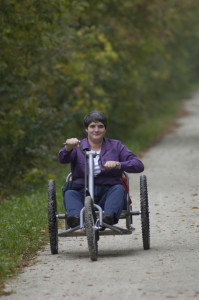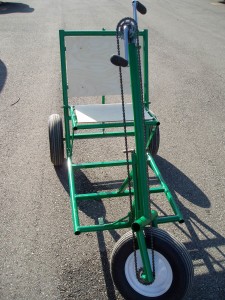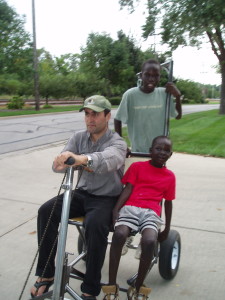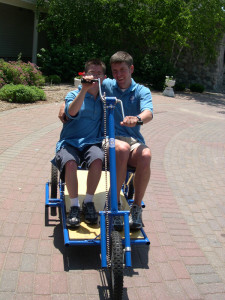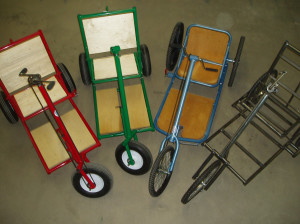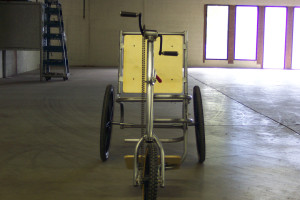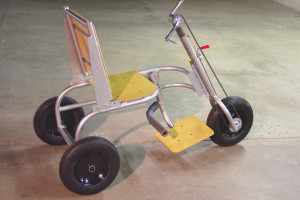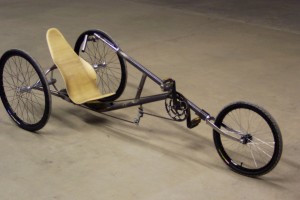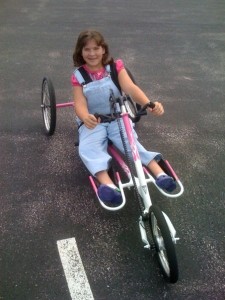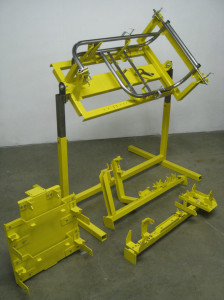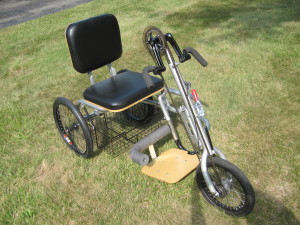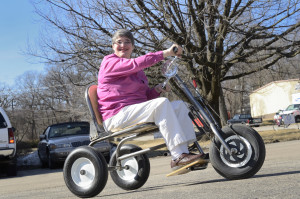Here are some of the HWI 22 different trike prototypes we have done between 2005-2015.
2005
The thought behind designing a low rider trike were as follows: It would be easy to enter the trike from the ground, it was appealing to the eye, it seems many men like low riders, it was a starting point.
The problems with a low rider are that it is too low to the ground, which would make visibility a safety issue. It was too long for the roads. Also being so low to the ground would make it hard to handle huge potholes.
2006
Second Prototype
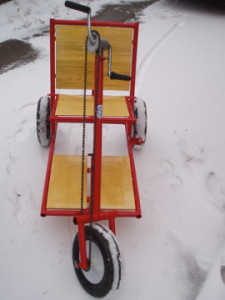 An upright trike where wheelbarrow tires accessible in the sandy area of the host country. With these direct drive wheels the trike can go forwards and backwards.
An upright trike where wheelbarrow tires accessible in the sandy area of the host country. With these direct drive wheels the trike can go forwards and backwards.
Problems include the middle bar was too high for lifting foot over. A chain connecting to the seat, allowing it to fold up made transfers into the trike difficult. The square seat tubing edges were a skin integrity hazard. The crank arms were too long, creating poor ergonomics.
Third Prototype,
We changed the direction of the seat tubing welds taking into consideration skin integrity issues and we removed the seat chain idea from the previous prototype.
Since this prototype would travel to North Africa as extra luggage it was designed to breakdown into two boxes. The front end is removable by a pin, and the seat can be removed from the frame.
This trike prototype was a safety hazard. The center of gravity was too high. The idea was to make bar that would serve as a parking brake and help a person transfer into the trike.
Fifth Protoype
This prototype uses 20 inch bicycle wheels, has outriggers for rear wheels, and a large under the seat storage area.
The problems with this prototype: It was too long and too awkward to maneuver.
2007
First Generation of Dual Offset Tube Trike (DOTT)
Dual offset tubing with canted rear wheels and coaster brake features. Seat and foot rest adjustments. Shorter crank arms as we began addressing proper hand-pedaled ergonomics. For more information on the DOTT design process.
The DOTT first generation with wheelbarrow wheels and a direct drive offering forward and backwards pedaling. The red lever is a parking brake, to keep the trike from moving while getting in but this design lacked a braking system.
Scirocco (African Wind) 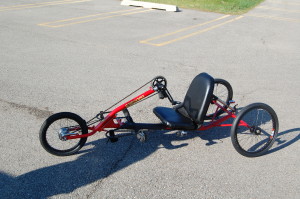
Scirocco, an experimental racing style hand pedaled trike. Designed with an internal 7 speed gear, with the shifter on the right side of the seat. The crank is a three-piece crank, set in the in-sync position and equipped with a coaster brake.Created to address the problem of entry and exit that exist with current racing trikes. Keeps the rider’s feet a safe distance away from the spinning spokes. With a very low center of gravity, young riders get the feel and performance of a real hand pedaled racer.
The Tomahawk was designed for conventional foot pedals. It is comfortable, equipped with dual inboard disc brakes, and a seven speed hub as a rear transmission behind the seat. The seat was specially designed and built for this tricycle of carbon/Kevlar and fiberglass to provide improved lateral support for the fast cornering.
2008
Pink Panther
The second hand-cycle racer prototype. Most of the same features as Scirocco.
DOTT Manufacture Fixtures
The DOTT series of tricycles were designed as part of a completely integrated approach, providing the builder with a “turn-key” system for manufacturing the tricycle. The four different assembly fixtures shown allow alignment and welding labor time to be reduced to less than 25% of what it would be if building one at a time. They also reduce the required skill level. Fixtures can rotate 360 degrees and lock at any convenient angle for loading, welding and removal.

2008-2010
DOTT Trikes: 2nd & 3rd Generation
HWI has done hand-pedaled trikeof the DOTT prototype. The design process has been done in cooperation with a multi disciplinary team of professionals taking into consideration proper ergonomics, necessary torso and leg angle adjustments. Being able to make adjustments in all major dimensions allows a wide older children and adults to fit into the trike and make adaptations as they grow. Our third generation presents the best all-around compromise between flexible ergonomics, performance, manufacturability and cost.
2010
HWI designed a commuter trike with a possible US market in mind. Our engineer designed an mechanism whereby the crank arms can go from an in-sync to out of sync position while riding. The trike can go up and down aisles at a grocery store and be used to commute to and from work. The trike is equipped with a coaster brake and an internal seven speed in the front hub.
2011-2014
Development of our DOTT compact trike. This trike fits someone who is about 5 years old to someone who is about 5’5″.
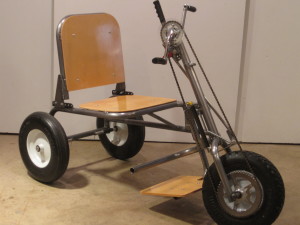
DOTT compact design with a steering tiller and brake system, which is controlled by the black handle pointing up in this picture.
2014-15
Research and Development on HWI’s trikes continue. As we’ve recognized the complexities in designing hand-pedaled three-wheeled trikes we have begun building a University Trike Consortium. By doing so we are partnering with schools, leveraging multidisciplinary student projects, as we continue ongoing trike research and development.
Olivet Nazarene University
Cargo Option: Undergraduate Senior Capstone Engineering Project
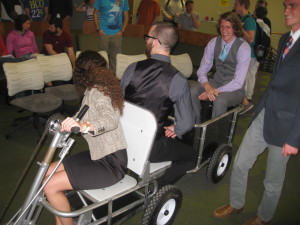
Three Mechanical Engineering students from Olivet Nazarene University spent undertook designing cargo option for HWI’s trike as their Senior Capstone Engineering Project. They came up with a behind the seat option for carrying another passenger, a below the seat ledge, and a trailer that hooks into a trailer hitch.
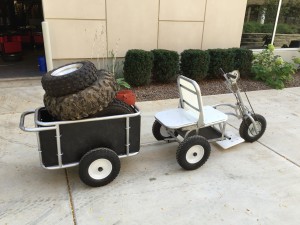
The trailer is able to hold well over 500 lbs. When unhitched from the trike it has a handle on the back that allows it to be used as a two-wheeled wheel barrow.




